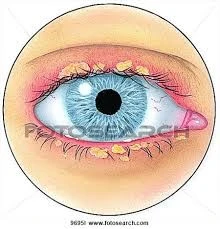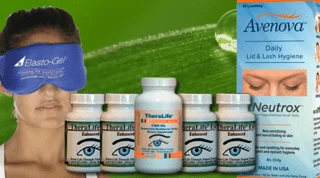Do you have chronic blepharitis?
Chronic Blepharitis treatment is very difficult.
TheraLife developed a comprehensive protocol that treats blepharitis for complete recovery. To learn more
The complications involve dry eyes, clogging of the tiny oil glands located on the eyelid called meibomian gland dysfunction (MGD).
Symptoms of blepharitis include red, swollen, crusty, itchy eye lids. In addition, eyelashes can fall out. This is why TheraLife treats all three (3) conditions to stop blepharitis.
Incidence
Blepharitis is a common eye disorder in the United States and throughout the world. This translates to more than 25 million Americans, and more than 60 million people worldwide suffering from blepharitis.
Moreover, blepharitis affects people of all ages and ethnic backgrounds. Meanwhile, approximately 86% of all people with dry eyes also have blepharitis.
What it is
Blepharitis is the inflammation of the eyelid. As a result, there is crusty, sticky material build-up is at the base of the eyelid where the eyelashes meet.
Consequently in the morning upon waking, the eyelids are glued shut which require soaking, scraping to get the eyelids open. In addition it causes decreased vision. But it does not cause severe impairment of vision.
However, complications such as clogged meibomian oil glands (MGD), and chronic dry eyes do lead to vision damages.
Most importantly, blepharitis causes discomfort and poor quality of life.
Types
1. Anterior blepharitis is infection on the outside of the eyelid. This is associated with bacteria and dandruff on the eyelid. Anterior blepharitis covers quickly with proper treatment.
2. Posterior Blepharitis
Posterior blepharitis affects the inner part of the eyelid. Moreover, posterior blepharitis is caused by clogged oil glands, acne rosacea, and seborrheic dermatitis (dandruff). Above all, these conditions are chronic where inflammation is the ongoing. Most importantly, chronic conditions can come and go, having periods of remission and flares.
To get complete recovery— treat Dry Eyes; MGD; and Blepharitis at the same time.
Causes
Common causes include:
1. Seborrheic Dermatitis – for example, dandruff- flakes stuck onto eyelids.
2. Bacterial infection – especially staphylococcus.
3. MGD – Clogged oil glands located on your eyelids. This is because oil glands make lubricants. Therefore, lubrication thicken your tears to prevent tear evaporation. Most importantly, clogged oil glands lead to chronic dry eyes.
4. Demodex – mites living on eyelashes
5. Allergies – for example to eye drop, eye makeup, contact lens solutions, cleaners, moisturizers, and environmental allergens.
Inflammation from chronic dry eyes causes blepharitis. Therefore, blepharitis, dry eyes, and MGD go hand in hand. This means all three give rise to a lot of inflammation. This tri-angle becomes a vicious cycle making recovery very difficult.
Conventional treatment
1. Eye drops to relieve dry eyes. The fact is, frequent use of eye drops make your eyes drier.
2. Antibiotic eye drops to control bacterial infection
3. Steroid eye drops to control inflammation. Most importantly, steroid drops have toxicity to the liver and kidney. Consequently, once you stop using steroid drops, the blepharitis symptoms return.
4. Warm compresses with a hot washcloth which is not hot enough.
5. Eyelid cleansing using baby shampoo.
There are shortcomings of conventional treatment.
First, dry eyes not appropriately addressed. This is because severe dry eyes often do not respond to eye drops.
Second, antibiotic use causes bacteria to mutate. Third, steroid use reduces inflammatory only temporarily. Conventional treatment leads to numerous cases of chronic blepharitis.
Best Treatment At Home With TheraLife
TheraLife developed a protocol with a three prone approach for blepharitis treatment at home. Reason is to stop this vicious cycle- Dry Eyes; Blepharitis; and MGD.
How Does This Protocol Work?-
1. Dry Eyes:
- TheraLife Eye capsules – a patented formula to restore, revive tear functions from inside out. It treats from within your body to help you make balanced tears on your own. It is strongly anti-inflammatory.
Above all, it is not an eye drop. Because it does not treat dry eyes from the surface of the eye. No more drops.
- -Omega 3 fish oil – which is a potent anti-oxidant and anti-inflammatory. Moreover, it helps provide lubrication by making tear thicker to prevent evaporation. TheraLife’s omega 3 fish oil is molecularly distilled for 100% purity. In short, Omega 3 fish oil helps to cure dry eyes.
2. MGD
Hot compress – this gel type of warm compress can be heated in the microwave oven for 20 seconds and place over the eyes for 10 minutes. This heat will help melt the clogging within the oil glands making it easier to get it out with eye massage. We highly recommend eye massage right after hot compress to ease unclogging.
3. Blepharitis
Eyelid cleanser – hypochlorous acid packaged in glass bottles. This is because hypochlorous acid in glass bottles will retain the integrity of the content until use.
To learn more, click here.
Why is Hypochlorous Acid Eye Lid Cleanser Important?
The type of eyelid cleanser does matter to the recovery. There are two main reasons
1. Stop the infection:
The use of antibiotics cause bacteria to mutate. This renders antibiotic ineffective. More over, we add to the pool of antibiotic-resistant bacteria.
Bacteria Protects Itself using Biofilm
Bacteria infect a tissue surface by creating a biofilm layer upon which it anchors onto and multiplies. It uses this biofilm layer to communicate with other bacteria in the same pool. This is because bacteria multiply every 20 minutes.
You can imagine how fast infections can spread. Hypochlorous acid disrupts this biofilm layer to stop bacteria from the re-attaching back onto the eyelid after cleaning.
It is like killing bacteria without using antibiotics. Most importantly, leave the hypochlorous acid on your eyelid afterwards. Do not wash off.
2. Gentle:
Hypochlorous acid is gentle on your eyelids. Most eyelid cleansers on the market are detergent-based. Therefore, they strip off natural lubricants on your eyelids. Above all, they make your eyelids sore, red, and irritated. This is because detergents will clean off the build up, but not prevent bacteria from re-attaching.
Tea Tree Oil is harsh on your eyelids
Tea Tree Oil eye lid cleansers are for treatment of mites on your eyelids. But Tea Tree Oil is very harsh and irritates the eyelids.
Hypochlorous acid is gentle and does not cause eyelid irritation. Most people are not allergic to hypochlorous acid.
Prevention
1. Keep your eyelids clean – especially before going to bed at night.
2. No eye makeup – especially during your blepharitis recovery phase. After that, you can go back to wearing makeup again. For Posterior Blepharitis, we recommend no powder or minimum make up at all times. This is because no makeup reduces the chance of recurrence and flares.
What To Do If You Are In A Flare
1. Dandruff shampoo when you wash your hair.
2. Massage your eyelids to release clogged material from your oil glands at night.
3. Stop wearing contact lenses. Wear glasses.
4. Reduce inflammation by changing your diet. For example, autoimmune diet; keto diet; vegan diet will all help you reduce inflammation and keep blepharitis under control.
To learn more, click here.
To watch a video- click here






how do I get your product?
Bob
Call us directly toll free 1-877-917-1989. or online at http://www.theralife.com
Tell me more about your dry eyes. I can help you.
Dr. Lily C. Yang
TheraLife Inc.
Buy it from us direct. Go to TheraLife.com and select the product. Can you tell me more about your dry eyes? Click here for the discounted starter kit. https://www.theralife.com/all-in-one-eye-enhanced-starter-kit/.
Call toll free if you are in the US or Canada 1-877-917-1989